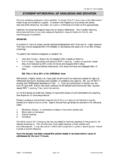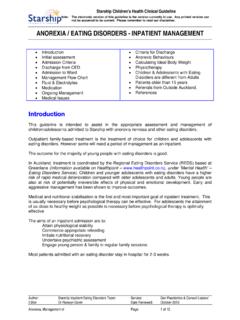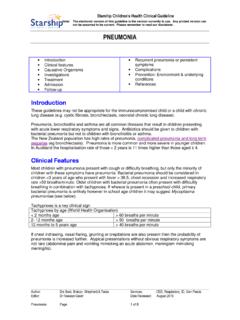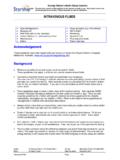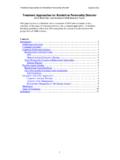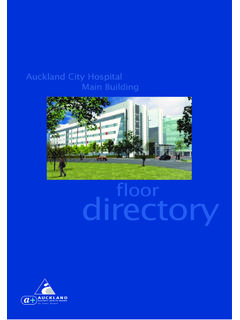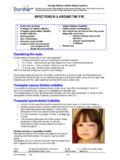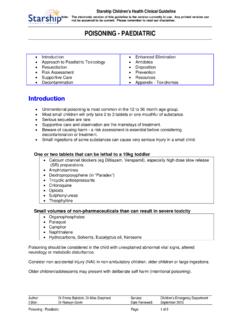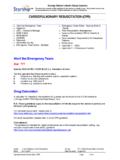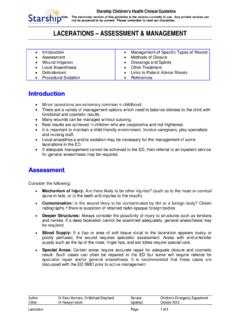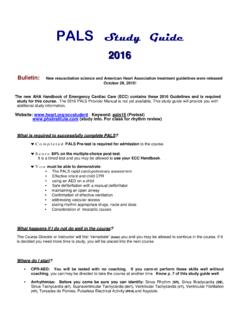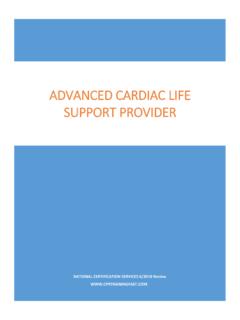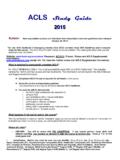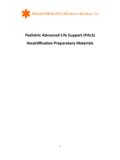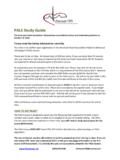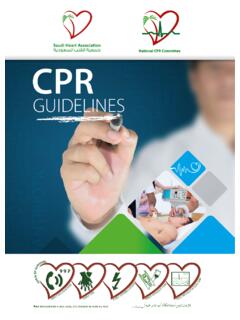Transcription of TACHYARRHYTHMIAS IN INFANTS AND CHILDREN
1 Starship CHILDREN 's Health Clinical Guideline Note: The electronic version of this guideline is the version currently in use. Any printed version can not be assumed to be current. Please remember to read our disclaimer. TACHYARRHYTHMIAS IN INFANTS AND CHILDREN . Principles of Management SVT Management SVT Algorithm SVT Ongoing Care VT Algorithm Ventricular Tachycardia (VT). Interpretations of ECG References Supra-ventricular Tachycardia (SVT). background Principles of Management Rapid heart beat in CHILDREN may be due to: Sinus tachycardia Supraventricular tachycardia (SVT). Ventricular tachycardia (VT). Post cardiac surgery, junctional ectopic tachycardia is common. The following guidelines give practical suggestions for the diagnosis and management of these problems. Relevant history, physical examination and investigations are important however effective intervention must not be unduly delayed.
2 Early consultation with paediatric cardiologist is desirable and is mandatory for patients with complex congenital heart disease. Recommended approach: 1. A,B,C assessment. Is the child in shock? 2. 12 lead ECG. Is there a tachyarrhythmia? Broad or narrow complex? P-waves? 3. Institute appropriate management (see below). 4. Concurrently consider underlying causes / precipitating factors. 5. Review diagnosis if management unsuccessful. 6. Repeat 12 lead ECG. 7. Arrange appropriate ongoing care and follow-up. Author: Dr Jon Skinner, Dr Mike Shepherd Service: Paediatric Cardiology/CED. Editor: Dr Raewyn Gavin Date Reviewed: March 2010. TACHYARRHYTHMIAS in INFANTS and CHILDREN Page: 1 of 8. Starship CHILDREN 's Health Clinical Guideline Note: The electronic version of this guideline is the version currently in use.
3 Any printed version can not be assumed to be current. Please remember to read our disclaimer. TACHYARRHYTHMIAS IN INFANTS AND CHILDREN . SVT Algorithm Yes No Shock present? Vagal Vagal manoeuvre manoeuvre (if no delays). Establishing vascular Yes Adenosine access quicker than 100 mcg/kg obtaining defibrillator? 2 minutes Adenosine 200 mcg/kg 2 minutes Synchronous Adenosine DC shock 1J/kg 300 mcg/kg Synchronous Consider: DC shock 2J/kg 400 500 mcg/kg Adenosine Synchronous DC shock Amiodarone or Procainamide or other Consider amiodarone antiarrhythmics (seek advice). SVT Algorithm, adapted from APLS Australia & NZ 2007. Author: Dr Jon Skinner, Dr Mike Shepherd Service: Paediatric Cardiology/CED. Editor: Dr Raewyn Gavin Date Reviewed: March 2010. TACHYARRHYTHMIAS in INFANTS and CHILDREN Page: 2 of 8. Starship CHILDREN 's Health Clinical Guideline Note: The electronic version of this guideline is the version currently in use.
4 Any printed version can not be assumed to be current. Please remember to read our disclaimer. TACHYARRHYTHMIAS IN INFANTS AND CHILDREN . VT Algorithm No Pulse VF protocol present? Yes Shock No present? Yes DC Shock*. Amiodarone 1 J/kg Over 4 hours in PICU. *use synchronous shocks first. If ineffective use asynchronous CONSIDER. Synchronous DC shock** DC Shock*. 2 J/kg **use synchronous shocks first. If no discharge use asynchronous *use synchronous shocks first. If ineffective use asynchronous Seek advice Amiodarone VT Algorithm, adapted from APLS, Australia & NZ 2007. Author: Dr Jon Skinner, Dr Mike Shepherd Service: Paediatric Cardiology/CED. Editor: Dr Raewyn Gavin Date Reviewed: March 2010. TACHYARRHYTHMIAS in INFANTS and CHILDREN Page: 3 of 8. Starship CHILDREN 's Health Clinical Guideline Note: The electronic version of this guideline is the version currently in use.
5 Any printed version can not be assumed to be current. Please remember to read our disclaimer. TACHYARRHYTHMIAS IN INFANTS AND CHILDREN . Interpretation of ECG. 1. Determine heart rate. One useful method is to count the number of RR intervals in six large squares then multiply by 50 see chart below for normal rates. 2. Is it the tachycardia wide or narrow complex? A QRS duration of > second at rates above 200 defines this see chart below for normal durations. 3. Can you identify P waves and what is their relationship to the QRS complex? They may be absent, hidden or inverted. There may be AV dissociation. It is best to assume a broad complex tachycardia is due to VT rather than SVT with aberration. The latter is much less common in CHILDREN . Separating sinus tachycardia from SVT can be difficult. If the child looks very sick, has a variability in heart rate, has a rate <220 bpm and a normal P axis, sinus tachycardia is more likely.
6 Conversely a fixed' heart rate >220 bpm in a relatively well looking child with a superior P axis is more likely to be due to SVT. Normal heart rates: Age (years) Heart rate (bpm) Tachyarrhythmia needs exclusion if a newborn or infant has a <1 110 160 heart rate >200 beats/minute, a toddler >180 beats/minute or a 1-2 100 150 school-aged child >160 beats/minute. Cardiac monitors are not 2-5 95 140 very accurate for heart rates above 200. 5 12 80 120. >12 60 100. Normal QRS Duration: Average (and upper limits) for age: 0-1 mo 1-6 mo 6-12mo 1-3 yr 3-8 yr 8-12 yr 12-16yr Adult Seconds ( ) ( ) ( ) ( ) ( ) ( ) ( ) ( ). Modified from Guntheroth WG Pediatric electrocardiography, Philadelphia 1965, Saunders Supra-ventricular Tachycardia (SVT) Background Supraventricular tachycardias (SVT) are common in infancy and childhood with an incidence between 1:250 to 1:1,000.
7 In 90% of cases it is due to a re-entrant rhythm and usually occurs in otherwise normal CHILDREN . 30-40% of CHILDREN presenting with new onset SVT, do so in the first few weeks after birth. SVT. can often be tolerated for many hours but because INFANTS cannot verbally communicate their perceptions of tachycardia, early signs may be subtle until they develop haemodynamic compromise. They may have poor feeding, tachypnea, pallor, sweating, lethargy and irritability. Latter signs and symptoms reflect a measure of congestive heart failure. In rare instances SVT. may have been present for days in a young infant . Older CHILDREN usually perceive tachycardia (palpitations) and may feel ill, breathless, sweaty, nauseated, dizzy or have orthostatic hypotension. Onset often occurs at rest, while they are sitting, reading, watching TV or in the 5-10 minutes after exercise.
8 SVT rarely occurs in sleep or causes syncope. Sudden death from SVT has been reported but is rare. Author: Dr Jon Skinner, Dr Mike Shepherd Service: Paediatric Cardiology/CED. Editor: Dr Raewyn Gavin Date Reviewed: March 2010. TACHYARRHYTHMIAS in INFANTS and CHILDREN Page: 4 of 8. Starship CHILDREN 's Health Clinical Guideline Note: The electronic version of this guideline is the version currently in use. Any printed version can not be assumed to be current. Please remember to read our disclaimer. TACHYARRHYTHMIAS IN INFANTS AND CHILDREN . SVT Management Vagal manoeuvres should be tried first but not cause undue delay. Technique is based on age: Neonates and INFANTS : Facial immersion in ice water. This technique must not be used for INFANTS in circulatory shock. The baby is attached to a cardiac monitor, arms are wrapped in a towel, the whole face is immersed in an ice water slurry for five seconds.
9 It is unnecessary to occlude the nostrils. This technique is safe and 90% effective in terminating a tachycardia. Explain carefully to the parents what you are doing. The baby will not drown! Toddlers: Ice cold facecloth to the face. Older INFANTS resist being dipped into the water as above but this technique is almost as effective. You should not use eyeball pressure as it can damage the retina. Unilateral carotid sinus massage can be used but is often difficult to perform. School-aged CHILDREN : Valsalva technique; ask the child to blow on their thumb after full inspiration for 10-15 seconds. Demonstrate the technique and have the child copy you. There should be no air escape and the child should be seen to strain (playing the trumpet silently). IV Adenosine: This is the drug of first choice for narrow complex TACHYARRHYTHMIAS .
10 This is both therapeutic and sometimes diagnostic. Technique is important due to a very short life. Give through a large vein (antecubital fossa) using a three way tap close to the cannula. Give adenosine on one port by rapid IV push. Follow immediately with rapid push of 5ml of normal saline through other port. First dose is 100 micrograms/kg followed by 200 mcg/kg then 300 mcg/kg (max 12mg). Record rhythm strip throughout (can use the defibrillator for this purpose), as may help later with diagnosis. Older CHILDREN complain of transient flushing, chest pain and nausea. INFANTS will frequently cry. The drug works by temporarily blocking the AV node and on ECG you frequently see a brief period of asystole before sinus rhythm returns. If the technique is correct and the child does not revert to sinus rhythm after the maximum dosage, you should REVIEW THE DIAGNOSIS.
